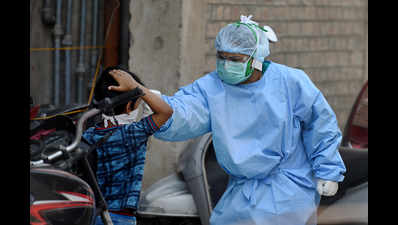- News
- City News
- chandigarh News
- New way of detecting corona: By the skin
Trending
This story is from July 14, 2020
New way of detecting corona: By the skin
The tiny virus that has gripped the world is now becoming visible on the skin.

In some patients, these signs appear late during the course of the disease, while in some it precedes the classical symptoms
CHANDIGARH: The tiny virus that has gripped the world is now becoming visible on the skin.
Several studies and data from Italy, Spain, and the US show that at least 20% of Covid-19-positive cases have skin manifestations. In some patients, these signs appear late during the course of the disease, while in some it precedes the classical symptoms.
As we enter the unlock phase amid rising Covid-19 cases and uncertainty, we learn more about the spectrum of these manifestations.Skin, the largest and outermost organ of our body, mirrors our internal body system. Even small changes on the skin can serve as markers to detect many undiagnosed or hidden internal diseases.
 Chandigarh-based dermatologist Dr Vikas Sharma said: "The skin manifestations of novel coronavirus were not recognised in the early stages of the pandemic but now as we learn more about, we observe that these range from pseudo-chilblains to a morbilliform (measles-like) exanthem, urticaria, vesicular eruptions, a dengue-like petechial rash and ovate scaling macules, and plaques mimicking pityriasis rosea."
Chandigarh-based dermatologist Dr Vikas Sharma said: "The skin manifestations of novel coronavirus were not recognised in the early stages of the pandemic but now as we learn more about, we observe that these range from pseudo-chilblains to a morbilliform (measles-like) exanthem, urticaria, vesicular eruptions, a dengue-like petechial rash and ovate scaling macules, and plaques mimicking pityriasis rosea."
Several studies and data from Italy, Spain, and the US show that at least 20% of Covid-19-positive cases have skin manifestations. In some patients, these signs appear late during the course of the disease, while in some it precedes the classical symptoms.
As we enter the unlock phase amid rising Covid-19 cases and uncertainty, we learn more about the spectrum of these manifestations.Skin, the largest and outermost organ of our body, mirrors our internal body system. Even small changes on the skin can serve as markers to detect many undiagnosed or hidden internal diseases.

Vesicular eruptions (skin erosion) appeared earliest in the course of Covid-19, prior to any other symptom in 15% of cases. Dr Sharma said: "These developed on the trunk and extremities, were most common in middle-aged adults, and lasted about 10 days typically. In contrast, the pseudo-chilblains eruption, which has received much attention, occurred later. In almost two-third (59%) of the patients, these lesions developed after other symptoms.”
End of Article
FOLLOW US ON SOCIAL MEDIA










